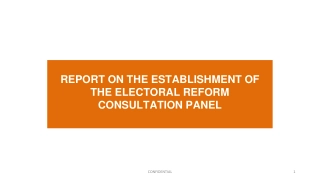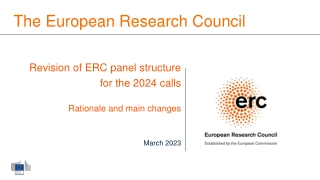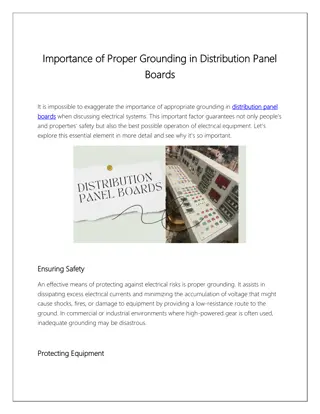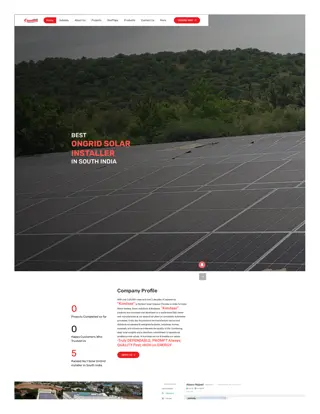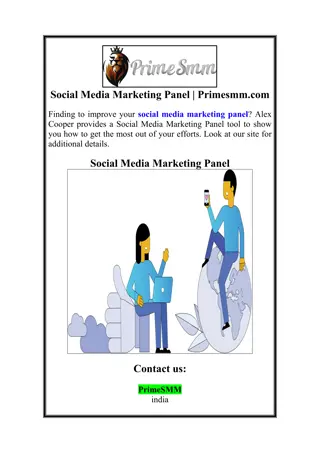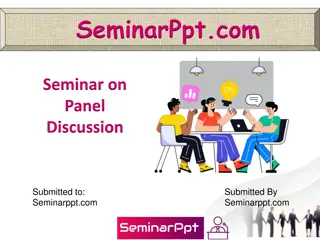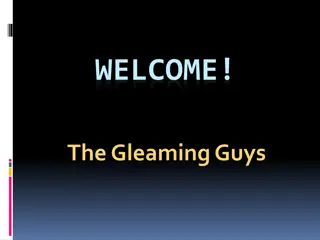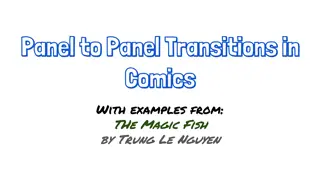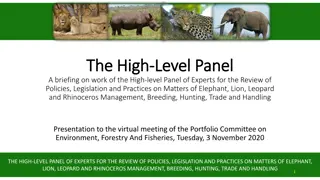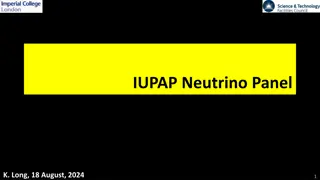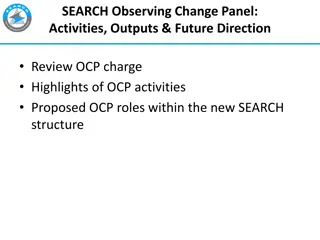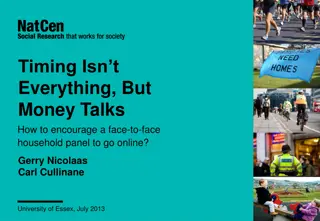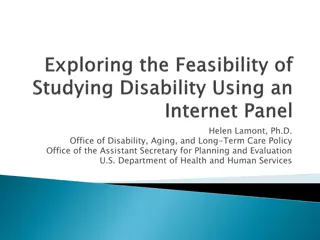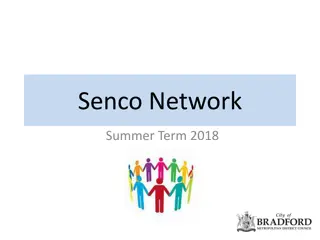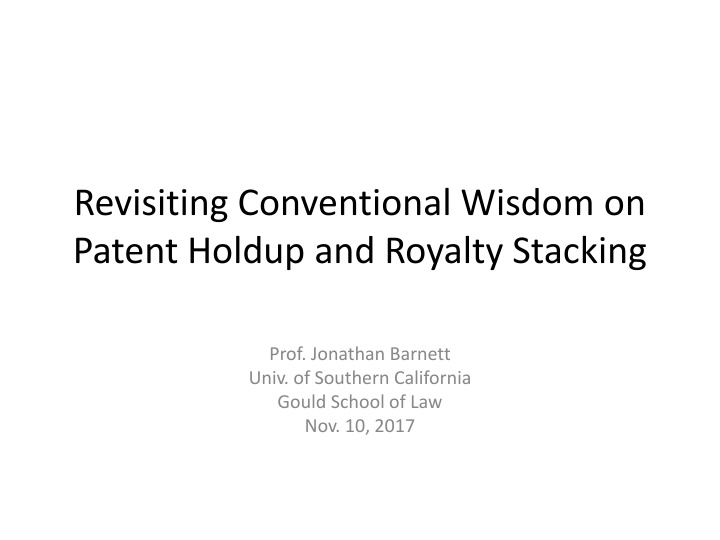
Revisiting Patent Holdup and Royalty Stacking Theories
Explore the impact of patent holdup and royalty stacking theories on policy and practice, as discussed by Prof. Jonathan Barnett from the University of Southern California Gould School of Law. Delve into the evolving landscape of patent law, including the shift towards de-propertizing certain patent rights and its effects on injunction relief and licensing practices.
Download Presentation

Please find below an Image/Link to download the presentation.
The content on the website is provided AS IS for your information and personal use only. It may not be sold, licensed, or shared on other websites without obtaining consent from the author. If you encounter any issues during the download, it is possible that the publisher has removed the file from their server.
You are allowed to download the files provided on this website for personal or commercial use, subject to the condition that they are used lawfully. All files are the property of their respective owners.
The content on the website is provided AS IS for your information and personal use only. It may not be sold, licensed, or shared on other websites without obtaining consent from the author.
E N D
Presentation Transcript
Revisiting Conventional Wisdom on Patent Holdup and Royalty Stacking Prof. Jonathan Barnett Univ. of Southern California Gould School of Law Nov. 10, 2017
Agenda Patent Holdup and Royalty Stacking Theories Theory Meets Policy: The Big Shift Theory Meets Evidence Revisiting Theory and Policy
Holdup and Stacking Theories Patent holdup Infringing party invests in adopting a multi-component product. In some formulations, infringing party does not know (or does not reasonably anticipate) that a critical component is patent-protected. Holder of patent on component threatens injunction and demands a licensing fee in excess of intrinsic value. Royalty stacking Multiple firms hold patents to different components of the same product. All components are critical. Individually rational profit-maximizing licensing by each patent holder results in total licensing burden that inefficiently reduces total revenues. Conventional wisdom: Holdup and stacking are significant problems (esp. in SEP markets), resulting in excessive licensing fees, settlements and damages, which inflates prices, restricts output and/or discourages subsequent innovation.
Influence of Theory on Policy: Words Year Agency Report References to Holdup References to Stacking 2003 FTC 35 22 2007 FTC, DOJ 9 18 2007 AMC 5 0 2011 FTC 115 0 2013 DOJ, PTO 5 0 Source: Barnett (2017 forthcoming)
Influence of Theory on Policy: Actions eBay v. MercExchange (S. Ct. 2006): As applied, no injunctive relief for NPEs (Seaman (2016): 16% injunction grant rate for NPEs). Patent Ambush Enforcement Actions (FTC, acting under Section 5) 2008: Rambus (FTC lost 2x at ALJ, DC Cir.) Business Review Letters (DOJ) 2006: VITA; 2007: IEEE; 2015: IEEE (amendment) Empowers SSOs to collectively predetermine RAND royalty rate (F)RAND Royalty Litigations (federal courts) 2013: MS v. Motorola; In re Innovatio -- specifically cite to holdup and stacking effects. 2014: Ericsson v. D-Link notes relevance but rejects reliance on holdup and stacking theories without specific evidence.
The Big Shift: De-Propertizing U.S. Patent Law Patent holders now exert weaker threat to seek injunctive relief in three key settings: (i) NPE, (ii) SEP and (iii) multi-component IT settings. Multiple actions indicate that injunctive relief may be unavailable for SEP holders. MS v. Motorola (2013, awards attorney s fees to alleged infringer) Apple v. Motorola (N.D. Ill. 2012, Posner, J.) FTC Consent Decrees (In re Bosch 2012; Motorola Mobility 2013) DOJ/FTC Joint Statement (2013) National Research Council/USPTO (2013) There is now doubt whether injunctive relief is available for a direct competitor in a multi- component scenario (see Apple v. Samsung (N.D. Cal. 2014), rev. Fed. Cir. (2014)). Sum-total effect: Absent credible threat of injunctive relief and/or treble damages, alleged infringers exert credible threat to substitute legal pricing for market pricing on grounds of holdup or stacking , inducing discount in general on patents in NPE, SEP and multi- component market segments.
Some Inconvenient Facts Since establishment of the Federal Circuit in 1982 and an increase in the strength of patent protection, there is no indication of any decline in national U.S. R&D intensity. Figure holds constant around 2.5% through 2006, after which it has jumped to approx. 2.75%. In patent-intensive ICT markets, output is up, innovation is constant, and quality-adjusted prices are down (Galetovic, Haber & Levine (2015)). In the patent-intensive smartphone market, sales increased approx. 900% from 2006-2012 and market concentration among device manufacturers has moved from highly concentrated to unconcentrated (Mallinson 2016). None of this is determinative. But it raises doubts concerning the conventional wisdom.
A Closer Look at Initial Evidence from the 3G Market Lemley/Shapiro (2007) referred to reports of double-digit royalty rates in the 3G market and conjectured that, if applied across multiple components, exorbitant rates may result. L&S mentioned reports of 22.5% rates for W-CDMA, 15-20% for GSM, and over 30% total royalty rates for dual-band smartphones, citing to Bekkers and West (2006). L&S noted that cross-licensing negotiations may reduce licensing fees. This is critical. Bekkers and West (2006): leading GSM vendors paid little or nothing due to cross-licensing ; B&W (2009): 20% rate is for non-IPR holders; an undetermined number of firms reduce or avoid royalties through cross- licenses. West (2006): Major European handset mfrs were believed exempt from patent royalties [in the GSM market] through cross-licensing . Estimates mfrs pay Qualcomm approx. 4.5% for WCDMA technology.
Empirical Evidence: Theory Comes Up Short Galetovic, Haber & Levine (2015): During 1997-2013, SEP-reliant industries experience faster quality-adjusted price declines than non-SEP-reliant industries. Gupta (2015): In 3G and 4G wireless markets (2004-2013), increasing R&D intensity, increasing participation in SSOs, increasing new product flow, and increasing entry by new device manufacturers. Galetovic and Gupta (2016): No evidence of royalty stacking in 2G, 3G, and 4G wireless standards markets. Output increases, price declines and increased entry at manufacturing level. Galetovic, Haber and Zaretski (2016): Estimated cumulative royalty rate on smartphone = 3-5.5% average sale price for 3G and 4G handsets. Similar results reached by Mallinson (2015) and Sidak (2016).
Weak Assumptions, Weak Theory Assumption #1: One-Shot Play. Reality: Patent holders seek to maximize long-term royalty streams over anticipated sequence of standards releases. This can result in low rates to seed market and encourage adoption. Assumption #2: Licensees Have No Foresight. Reality: Licensees are sophisticated and, absent sufficient assurances, will demand discount or contractual offsets against future anticipated holdup or stacking behavior. Assumption #3: Licensors Are Unilateral Price-Setters. Reality: Standards always compete at outset and future dominance of standards development (3G, 4G, 5G) is never assured. Assumption #4: Licensors Cannot Signal. Reality: Evidence that licensors periodically signal licensing intentions to the market. This is facilitated by small numbers, repeat play.
Rethinking Policy If the empirical evidence is weak, then so too is the big policy shift , which is implied by the underlying theories. Eroding property-rule protections (esp. injunctive relief) for patentees (including SEP holders) substitutes legal pricing for market pricing. Given the apparent infrequency of holdup and stacking, this major policy shift fails an error-cost test. Principal error costs: (i) resource misallocation; (ii) organizational distortion; and (iii) monopsony risk.
R&D Intensities for Selected Technology Firms (2014 or 2015) Firm R&D Intensity Substantially Integrated? Rambus 38% N Intel 21.9% Y Qualcomm 20.8% N Cisco 12.85% Y IBM 6.42% Y Panasonic 5.93% Y Sony 5.65% Y Toshiba 5.18% Y LG 4.21% Y HP 3.1% Y Source: Barnett (2017 forthcoming). Calculations based on annual company reports
Monopsony Risk in RAND-Governed Markets Holdup/stacking theories posit excessively high royalty rates demanded by patentee-licensors. Ignores possibility that SSO structure enables licensees to collectively exert buying power, potentially resulting in royalty rates that are excessively low (Sidak 2008). Recognized by DOJ in business review letter (1997). Preliminary evidence: MPEG LA patent pools are dominated in terms of contributions and governance by integrated hardware manufacturers with relatively low R&D intensities. Upstream firms with high R&D intensities consistently decline to participate (Barnett 2014). Revealed preferences: in amicus briefs filed in recent leading SEP litigations, upstream firms often favor the patentee; implementer firms always favor the infringer (Barnett 2017 forthcoming).
Conclusions Holdup and stacking theories have influenced recent changes in patent law and patent-related antitrust law. Those changes have limited injunctive relief for significant classes of patentees, esp. in SEP markets. There is little evidence to support these theories. On a cost-benefit basis, the big policy shift is almost certainly unsound. Eroding injunctive relief may give rise to significant welfare losses, including (i) resource mispricing; (ii) organizational distortion; and (iii) monopsony risk.
References Jonathan M. Barnett, Has the Academy Led Patent Law Astray?, Berkeley Technology Law Journal (2017 forthcoming) Jonathan M. Barnett, From Patent Thickets to Patent Networks: The Legal Infrastructure of the Digital Economy, 55 JURIMETRICS J. 1 (2014) Rudi Bekkers & Joel West, The Effect of Strategic Patenting on Cumulative Innovation in UMTS Standardization 10, 22 (Dynamics of Insts. & Mkts. in Eur., Working Paper No. 9, Mar. 2006) Rudi Bekkers & Joel West, The Limits to IPR Standardization Policies as Evidenced by Strategic Patenting in UMTS, 33TELECOMMUNICATIONS POLICY 80 (2009) Mark A. Lemley & Carl Shapiro, Patent Holdup and Royalty Stacking, 85 TEX. L. REV. 1991 (2007) Alexander Galetovic and Kirti Gupta, Royalty Stacking and Standard Essential Patents: Theory and Evidence from the World Mobile Wireless Industry, Working Paper (2016) Alexander Galetovic, Stephen Haber, and Ross Levine, An Empirical Examination of Patent Holdup, 11 J. COMP. L. & ECON. 549 (2015). Alexander Galetovic, Stephen H. Haber and Lew Zaretzki, A New Dataset on Mobile Phone License Royalties, HOOVER INSTITUTION WORKING GROUPON INTELLECTUAL PROPERTY, INNOVATIONAND PROSPERITY, WORKING PAPER SERIES NO. 16011 (2016) Kirti Gupta, Technology Standards and Competition in the Mobile Wireless Industry, 22 GEO. MASON L. REV. 865 (2015) Keith Mallinson, Cumulative Mobile SEP Royalty Payments No More Than Around 5% of Mobile Handset Revenues, WISE HARBOR (2015) Keith Mallinson, Don t Fix What Isn t Broken: The Extraordinary Record of Innovation and Success in the Cellular Industry under Existing Licensing Practices, 23 GEO. MASON L. REV. 967 (2016) Christopher B. Seaman, Permanent Injunctions in Patent Litigation after eBay: An Empirical Study, 101 IOWA L. REV. 1949 (2016) J. Gregory Sidak, Holdup, Royalty Stacking, and the Presumption of Injunctive Relief for Patent Infringement: A Reply to Lemley and Shapiro, 92 MINN. L. REV. 714 (2008) J. Gregory Sidak, What Aggregate Royalty Do Manufacturers of Mobile Phones Pay to License Standard-Essential Patents?, 1 CRITERION J. INNOVATION 701 (2016) Joel West, Does Appropriability Enable or Retard Open Innovation?, in Henry Chesbrough, Wim Vanhaverbeke and Joel West eds., OPEN INNOVATION: RESEARCHINGA NEW PARADIGM (2006)

